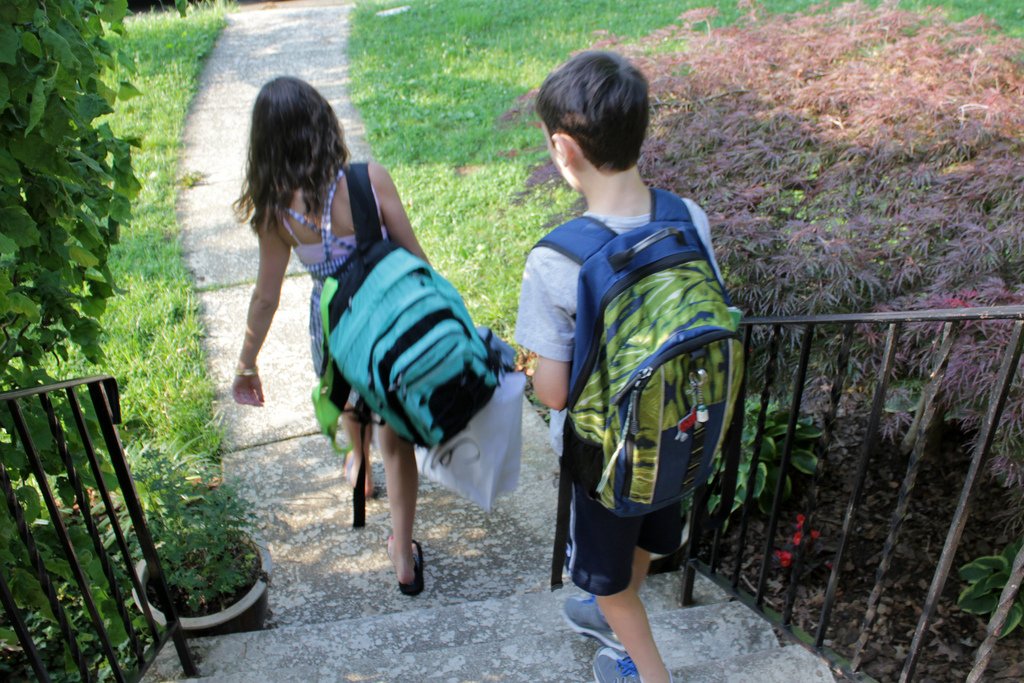School Backpack Alert: Risks and Tips

September 20th slipped by pretty much unnoted by most of us, as we settled into the post-back-to-school rush. With recently purchased supplies, paper, pencils and tech devices firmly secured in our kids’ backpacks-right there along with textbooks, lunch bags, and probably water bottles, too-by then we’d we all gotten back to the business of our lives. [wp_ad_camp_1]
But, in truth, we parents should have paused that day and taken a better look at the loads our kids haul back and forth to school; better late than never, though, for sure. It matters so much that the American Occupational Therapy Association actually set aside a National School Backpack Day-September 20..
Have your doubts? The next time you’re stuck behind a school bus, watch the kids as they either get on or off. You’re quite likely to see too-heavy backpacks slung over just one shoulder or hanging low down on backs. The posture effect: Kids listing to one side or with head and back pressed forward, nothing upright about it…
As for that weight factor, Simmons College professor Shelly Goodgold explains that, “When you carry something that is really heavy, your head goes forward, and you lean forward. This can produce strains in the neck and strains in the back… ”
The problem, Karen Jacobs, a clinical professor in occupational therapy at Boston University, says is that, “Backpacks become a portable life support system, filled with supplies and goodies students probably won’t need that day but feel they must carry.”
Or as one eighth grader put it, “Everything that matters to me is in my bag; you never know when you’re gonna need something, and this way I’ve it’s right there with me, not stuck in my locker or at home.”
No wonder, then, that the U.S. Consumer Product Safety Commission finds that some 14,000 kids are treated with related injuries every year. That, in turn, should be sending out all sorts of warning bells, but what’s a parent to do?
For starters, take heed if you hear your child grunt when either shouldering or removing the backpack. Ditto for complaints of tingling shoulders, arms and/or fingers; another red flag is shoulder redness or “dents.”
Then follow the American Academy of Pediatrics warning that a backpack, at most, should weigh between 10% and 20% of your child’s body weight; better yet, says the organization, aim for between 10% and 15%. In other words, put it on a scale.
For that matter, the American Occupational Therapy Association goes one better recommending 15% max!
Makes sense, and yet, according to University of Michigan researchers, the average middle schooler lugs around a backpack weighing in close to 14 pounds, thus easily hitting that 15% mark. More alarming is that for 23% of the kids, that figure came in at least 20%.
And all that can end up as aches, pains, and injury from the neck down to the hips and knees.
And don’t think a rolling pack is the perfect solution. Not only are they unwieldy on stairs, ice, and snow, they constitute a tripping hazard both in classroom aisles and school hallways, so many districts ban them.
So, if your kid weighs…
- 50 pounds go for no more than 7.5 pounds;
- 80 pounds go for no more than 12 pounds;
- 100 pounds go for no more than 15 pounds, and so on.
And then, check to make sure your child’s backpack:
- Is a good fit, neither wider nor longer than his/her torso;
- Doesn’t hang more than four inches below the waist;
- Has both padded shoulder straps and back;
- Is equipped with chest and hip straps to help distribute some of the weight to the hips.
- Packs only the essentials;
- Spreads the weight around by using all of the compartments;
- Places the heaviest items in the middle of the bag and closest to his/her body;
- Takes an empty not full water bottle, to be filled at school;
- Tightens and uses both straps, so that the bag sits mid-back, not on the butt.
Bottom line: Be safe, not sorry, even if it means shopping for a replacement-and keep your fingers crossed that your child pays attention to this advice, too!



